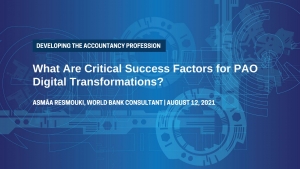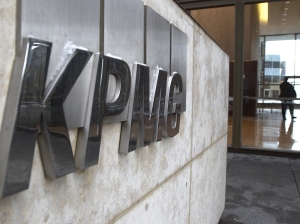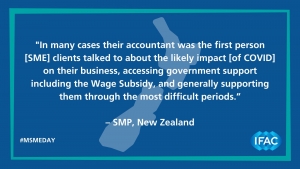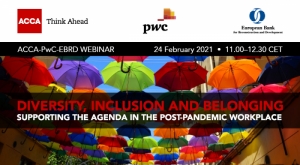عرض العناصر حسب علامة : فيروس كورونا
كورونا تدفع واحدًا من كل عشرة شباب لتغيير مسارهم الوظيفي
يدفع الوباء واحدًا من كل عشرة شباب لتغيير مسارهم الوظيفي، وفقا لجمعية المحاسبين القانونيين المعتمدين (ACCA)
معلومات إضافية
-
المحتوى بالإنجليزية
A new poll commissioned by ACCA (the Association of Chartered Certified Accountants) suggests the Covid-19 pandemic has proved to be a time of career contemplation and change for young people.
There are around six million 16 - 24 year olds in the UK, and ACCA polled over 1,000 to better understand their views about jobs. While before the pandemic 21% wanted to pursue a professional career like accountancy, that figure has now increased to 30%.
Being on furlough has offered a lot of people already in work the chance to reassess and aim to take new qualifications to target a new job.
40% of those surveyed said financial security is most important to them in their job and that traditional career paths with qualifications helped increase the chances of that job and financial security. There was a fifty-fifty split on the numbers of people aiming to go to university and those who said it wasn’t for them. The numbers of people wanting to go into apprenticeships - or aiming to work and study at the same time - now matches the number of people wanting a place at university.
Helen Brand, chief executive of ACCA says: ‘The Covid-19 crisis has made many rethink career aspirations and their futures. This research, alongside a global survey we did earlier this year into Gen Z and their careers, shows how the pandemic has transformed aspirations about the world of work, while also shaking up how employers run businesses and organisations. The role of accountants is wider and more important than ever before, offering a secure and flexible career whatever your age.
‘For Gen Z, developing strategic accountancy skills offers a great launchpad into a career, with benefits our research shows that they crave – such as the opportunity to learn valuable skills and progress rapidly; to be paid well and enjoy greater security of employment; to enjoy a good work-life balance; with varied and meaningful work for organisations with purpose and values, and also the opportunity to make a contribution towards a better, fairer, more sustainable future for all.’
ACCA has three case studies of people who have been inspired to recently pursue a career as finance professional, making the change during and before the pandemic:
24-year-old Cristina Oprea from Greenwich in SE London was a chef in a nursery before being furloughed in Spring 2020. With some time to plan her future afresh, Cristina opted to study an accounting degree with the ACCA. Cristina now works as an Accounts Assistant for a care company while continuing her studies. She has now purchased her first property before the age of 25.
37-year-old Gaurav Kumar from Ashton-under-Lyne in Greater Manchester worked in the hotel industry looking after serviced apartments that were forced to close by the pandemic. While furloughed, he enrolled with the ACCA. He’d always loved working with numbers and has now started a new job at Barclays while he continues his studies.
37-year-old Craig Maclean from Cambuslang, on the edge of Glasgow, was a baker with Greggs for nearly 20 years. Wanting a career change, he’s now switched to studying at the University of the West of Scotland for an ACCA accredited degree. He’s also working at the university as a Finance Administrator.
Helen Brand concludes: ‘The pandemic has initiated a change in career outlook, and we also see this being played out on our global jobs board, ACCA Careers, which has recently seen a 43% year on year global uptick on usage. This shows a level of demand not seen before, and which we believe will continue.’
ما هي عوامل النجاح الحاسمة للتحولات الرقمية لمنظمات المحاسبة المهنية؟
تقدم أسماء الرسموقي مستشار البنك الدولي 5 ركائز أساسية يجب أن تضعها منظمات المحاسبة المهنية لإحراز تقدم ناجح في التحول الرقمي.
معلومات إضافية
-
المحتوى بالإنجليزية
What Are Critical Success Factors for PAO Digital Transformations?
ASMÂA RESMOUKI, WORLD BANK CONSULTANT | AUGUST 12, 2021
There is a significant opportunity for Professional Accountancy Organizations (PAOs) to accelerate digital transformation to improve the delivery of their mandate. This was evident through a recent World Bank project that engaged with Board members and senior management of 20 PAOs in Sub-Saharan Africa, Middle East & North Africa (MENA), Latin America, and the Caribbean regions regarding their digital transformation journeys.
“We need to accelerate adoption of digital transformation to enhance services to our members and public”
“We need to design a digital transformation strategy supported by financial and human resources to leapfrog our service offering during the COVID 19 period”
“Digital transformation will assist us to support prospective accountants in rural areas”.
These were some of the sentiments that were expressed by Board members, and by speakers and participants during the knowledge event hosted by IFAC and the World Bank on PAO digital transformation (available in English and French).
Based on the conversations, the following are 5 key pillars that PAOs should put in place to successfully progress their digital transformation.
1. Governance: Tone at the top should set direction
Throughout the project, it was noticeable that when the PAO President and Board members had a clear vision and were committed to the digital transformation reform, there was commendable and concrete progress. The opposite was also true: i.e., minimal digital transformation among PAOs where leadership did not show enough enthusiasm for the reform or consider it a priority. Therefore, it is important for the Board to take the leading role in setting direction and really driving the necessary changes.
2. Design and implement a user-centric digital transformation strategy
Digital transformation requires a clearly articulated strategy that defines strategic objectives, implementation plans, and performance targets with timelines (Key Performance Indicators).
When designing the strategy, the Board should engage with the membership and all relevant stakeholders to ensure their needs and expectations are incorporated. The final strategy should then be shared and communicated with them. Subsequently, the PAO leadership should regularly request feedback from members and stakeholders on any new digital tools and request suggestions to improve the user-experience. This would create a virtuous circle between the PAO and its stakeholders.
Ideally, the digital strategy should be linked to the overall strategy of the PAO, since digitalization serves as a tool to execute the overall strategy. The Ordre National des Experts Comptables et des Comptables Agréés du Burkina Faso is a good example of a small PAO which has designed its digital transformation strategy using guidance from IFAC’s Information and Communications Technology (ICT) Guide.
3. Be connected and benefit from the country digital economy eco-system
PAOs should be aware of digital transformation reforms in their country and maintain close working relationships with the governmental departments and officials driving the reform. Government reforms seem to be focused on strengthening national infrastructure to improve access and reduce cost, enhancing digital skills, offering digital public and business platforms to accelerate the use of e-services, and strengthening digital enablers like cybersecurity and data protection. These initiatives can have a direct impact on PAOs’ digitalizlation initiatives.
Therefore, it is crucial for PAOs to follow and engage with the right stakeholders regarding national digital transformation reforms to determine they can benefit from such a reform and related activities. This could include empowering their members with greater digital skills by including technology skills in the accounting qualification curriculum and offering regular digital courses in the CPD program.
4. Adequate human and financial resources
Without dedicated human and financial resources, it is a challenge to implement a successful digital transformation reform. This does not necessarily mean having massive and seemingly unlimited resources. It means making smart investments now for better returns and savings in the future. Therefore, PAOs might need to be creative in securing the financial and human resources required to implement their digital transformation strategy.
Securing funding could mean re-prioritizing the available budget to focus on digitalization activities which will add value to members and save costs in future, requesting members to contribute to a special fund for the reform, securing sponsorship, and/or applying for government funding or donor funding, etc.
For example, the Ordre des Experts-Comptables de Côte d’Ivoire partnered with the national tax authority to support taxpayers in filing their financial statements on an online platform. Whenever a member does an online filing, a specific fee is submitted to the PAO, in turn, creating a new alternative revenue stream.
Human resources are also essential. Depending on the financial resources available, PAOs could either designate someone from their secretariat to lead the initiative, engage a consultant, outsource the function or set up a special Digital Transformation Committee with a clear terms of reference.
5. Partnering with others
PAOs should explore partnerships and leverage their IFAC membership and IFAC’s Network Partners. Such partnerships would enable them to benefit from global and regional resources and knowledge-sharing opportunities.
Similarly, PAOs should partner with other PAOs, especially those who have progressed with digitalization reforms already. Such PAOs can serve as mentors: sharing experiences on how they have walked the transformation journey, provide advice and guidance on when and where to purchase new softwares or technologies, and/or provide input to a PAO that is developing its digital strategy, etc. PAOs are encouraged to raise their hands and seek help and support whenever needed.
In closing, while the level of progress varies from PAO to PAO, the challenges for smaller PAOs oftentimes remain greater given their limited resources. Yet, “small streams make big rivers” — starting with small actions and building on them with regularity and consistency should allow PAOs to be successful in achieving their digital transformation goals. All PAOs are invited to consider the above pillars to start or accelerate their digital transformation to efficiently and effectively deliver on their mandates.
ندوة الويب: مساعدة المنظمات غير الربحية على التنقل في المستقبل
معلومات إضافية
- البلد عالمي
- نوع الفعالية مجانا
- بداية الفعالية الثلاثاء, 27 يوليو 2021
- نهاية الفعالية الثلاثاء, 27 يوليو 2021
- التخصص محاسبة ومراجعة
- مكان الفعالية أونلاين
كيف يمكن لشركات المحاسبة الحماية من تهديدات أمان العمل عن بُعد؟
معلومات إضافية
-
المحتوى بالإنجليزية
How accounting firms can protect against remote work security threats
By Sarah A. Lynn, Douglas G. Schultz
July 14, 2021, 11:45 a.m. EDT
5 Min Read
Facebook
Twitter
LinkedIn
Email
Show more sharing options
The COVID-19 pandemic has fundamentally changed the way people work. Millions of employees have been able to stay productive while working from home during the lockdowns thanks to remote collaboration technologies like Zoom, WebEx and Teams. Very quickly, virtual meetings became ever-present, and people could connect with their managers and clients or give presentations from any location with internet access, including other countries. Even as much of the country returns to business (mostly) as usual, firms instituting flexible or work-from-home policies may need to review their telecommuting policies and practices to help keep data safe.
While working from home has been key to business continuity over the last 15 months, it has also opened up some potentially major security issues for firms. In an office setting, there are multiple ways to secure data, including firewalls and physical security measures such as badges, doors, locks and keys. However, remote employees could be working from their homes, their cars, or at a local coffee shop. They have laptops, mobile phones, tablets and smartwatches — all of which communicate with each other and could use several different services (Wi-Fi, Bluetooth, cellular data, RFID).
Being outside a secure office makes these employees, and their data — that is, your data and your client’s data — vulnerable to data leaks and hacks. Even something like a chat or text message could contain confidential information, such as a Social Security number, birth date, tax information, or even medical information.
This is why robust data security is vital for any company. Data breaches that compromise client or employee data are notoriously costly, averaging over $3.9 million in 2020. They not only hurt a firm's reputation and bottom line but can also result in the theft of client information, proprietary information or intellectual property. Think of all the due diligence-related information your firm has on clients who might be preparing for an IPO or merging with another company.
It's these risks, by the way, that drove the American Institute of CPAs to add to its Code of Professional Conduct Confidential Client Information Rule 1.700.001, which deals with disclosure of confidential client information without the specific consent of the client. This rule goes hand in hand with Internal Revenue Code Sec. 7216, where failure to comply can lead to fines and other consequences.
It is against that background that all firms must make a concerted effort to be vigilant about protecting their data and their client’s data. Accounting firm leaders must recognize the issues affecting their firms and take measures to educate their professionals. With that in mind, here are a few practical ways to help secure access to data, stay compliant, and mitigate the damage in the event of a breach.
Encryption is your friend
You may have outfitted all of your employees with laptops and a secure virtual private network. While a VPN might be enough protection when employees use their devices on a secure home network, what if they’re traveling or decide to work in a cafe? Many hotels, airports and cafes offer free Wi-Fi, but these unsecured networks can allow hackers to gain access to data that is supposed to be secure. A VPN may protect outbound data, but it still leaves the laptop or tablet itself vulnerable via other potentially active services such as Bluetooth, hotspots or RFID. Encrypting the device itself will make it much harder for criminals to access the data.
Encryption can also help protect a device if it is physically stolen. Unattended computers, tablets or mobile phones are tempting targets for thieves. With the device in their possession, the thief could have a treasure trove of confidential information they can sell or use to scam your clients. If a device is encrypted, the data is safe, and you only lose the device. It could mean the difference between $1,000 or $1,000,000.
Turn off services
Mobile devices are designed to make communication easy. This is a double-edged sword, however, unless there are security protections in place. For example, virtually all mobile devices have Bluetooth, and a growing number can be used as internet hotspots or have radio frequency identification (RFID) technology built right in. If these services are turned on, a hacker could potentially compromise the device. While these services can be beneficial, they do not need to be active 24/7. All employees should be instructed to turn them off until they are needed, especially while traveling.
Make sure to back up your data
With millions of Americans telecommuting, tens of millions of laptops and other devices are floating around filled with potentially sensitive data. This creates a greater chance that data could be lost if a device is lost, stolen or damaged. Employees should back up their devices daily, or at the very minimum, weekly, so the information will remain accessible if there is a catastrophic failure. Moreover, it is vital that employees restrict backups solely to company-approved destinations (e.g., cloud storage, on-premises servers, encrypted hard drives). If they make a backup to another location, it exposes their organizations to a potential data breach they have no control over.
As a firm leader, you should work with your IT team to ensure the mobile devices with access to firm information use properly “containerized” apps such that your firm’s data is automatically backed up, even if the rest of the device’s data is not. Note that even email and everyday collaboration tools are loaded with documents and sensitive data that could be easily leaked. To reiterate, always (1) encrypt the devices and (2) back up important information.
A few decades ago, it was practically unthinkable that employees would have access to a secure server from their home, or for them to be a potential target for hackers. Accounting firm leaders must adapt their security practices to the time and, perhaps most importantly, educate employees about cybersecurity. Even with just these three relatively simple steps, firms can significantly reduce the chances of being subject to a costly data breach or cybercrime incident.
كي بي ام جي KPMG توسع الخدمات البيئية والاجتماعية والحوكمة
تعمل KPMG على زيادة جهودها لتوفير الخدمات البيئية والاجتماعية والحوكمة للعملاء من خلال مبادرة جديدة تسمى KPMG Impact.
معلومات إضافية
-
المحتوى بالإنجليزية
KPMG has been increasing its efforts to provide environmental, social and governance services to clients through a new initiative called KPMG Impact.
The team will help clients improve their ESG performance while also carrying out KPMG’s own ESG commitments. Last year, KPMG U.S. worked with other businesses, investors, standard-setters, non-governmental organizations and international organizations through the World Economic Forum to create a set of 21 core metrics for companies to disclose their progress in the ESG areas of people, planet, prosperity and governance. KPMG has adopted those same metrics to guide its actions and measure and report its progress.
The move comes as more accounting firms wade into providing ESG reporting and assurance services for clients. ESG funds have become a popular vehicle for investors, and the Securities and Exchange Commission is weighing requirements for climate risk disclosures by companies. At the same time, at the global level, securities regulators around the world are pushing for greater consistency in reporting ESG metrics, encouraging standard-setters to align their various standards and frameworks more closely together. The International Financial Reporting Standards Foundation has been working on creating a proposed International Sustainability Standards Board that it would oversee alongside the International Accounting Standards Board. IFRS Foundation trustees explained how the structure would work during a webinar Wednesday.
Using Too Many Systems? Accounting Practice Management all in One Place
Canopy is a full-suite practice management software for accounting firms offering client management, document management, workflow, and time and billing...
SPONSOR CONTENT FROM CANOPY
This move toward greater sustainability reporting and assurance is one that KPMG has already been working on for years, but it’s taken on greater urgency as climate change risks appear to have grown with rising temperatures seen in the U.S. and across the globe.
The offices of KPMG in ChicagoTANNEN MAURY`/BLOOMBERG NEWS
“At the highest level for us, the backdrop for the rise of ESG is it’s all about trust,” said KPMG Impact leader Rob Fisher. “You see people looking to business as an ethical and effective leader to bring ESG aspirations to life, and the recent decline in trust that we see across institutions like government and media and so on affects our ability to come together and solve problems. That’s why a focus on organizations doing well across environmental, social and governance dimensions can really build trust with customers, employees, investors, regulators and really all stakeholders. We think ESG engagement will make businesses better by unlocking new value, building resilience and driving profitable and measurable growth both today and tomorrow.”
He has been working with clients on taking individual approaches to ESG reporting. “As I think about specific client conversations that I’m having, it’s that every business across all industries is on a unique ESG journey that reflects its stakeholders, challenges and opportunities,” said Fisher. “Effective engagement really has to be embedded throughout a company’s entire strategy and operations. Many of the clients we are working with are actually the leaders in their industries in areas like climate, the environment, social justice and so on, but they’re still looking for our help in how they bring it all together and figuring out the opportunities to improve.”
ESG encompasses not only the environment, but also social initiatives like diversity, equity and inclusion, and the firm is helping clients with those efforts as well. That includes providing assurance services.
“There are four big buckets of work that we’re doing for clients,” said Fisher. “One, we’re helping clients develop a broader ESG strategy, and then the second part is how do you operationalize that strategy. We’re seeing a lot of interesting opportunities around transformational opportunities and the ability to create some value, and we’re really seeing financial institutions and private equity leaning in because of that. There’s a ton of investor demand in that regard. The fourth bucket is around helping companies figure out how to measure it, report it, and assure it. Certainly there are a number of different standards and different frameworks and metrics for reporting ESG data, and we’re really working with clients to help them understand, based on perhaps the specific interests of particular investors or the industry that they’re in, what frameworks are going to make the most sense to help them develop capabilities to measure their return on their ESG [efforts]. You want it to be accurate and fit for purpose disclosure type of reporting.”
Last month, KPMG submitted a comment letter to the SEC in response to the SEC’s request for public input on climate change disclosures. “Ours is really about a building block approach at a high level,” said Fisher. “We support a global baseline. Then there would be supplemental standards to serve specific jurisdictional needs. I think the importance of some sort of consistency at the global level is that, if we don’t have that, disclosures will be less consistent and comparable. Registrants are operating across multiple jurisdictions and their supply chains and their customer base are certainly going to be global. We really think it has to start with a baseline and then additional disclosures that would be necessary in the context of the U.S.”
Becker Professional Education has been seeing growing demand for its Continuing Professional Education courses on ESG, with Tim Gearty, national director and editor-in-chief at Becker, conducting 40 to 50 sessions per month on ESG for companies across industries.
“Europe seems to be taking the lead on this,” said Gearty. “We in the United States are catching up quickly, but the European Union clearly took the lead on this, and they’re pushing ahead. We’re still in a catchup mode, but we have a lot of great thought leaders that are working very diligently to make sure that our standards are ultimately measurable and that assurance can be given to them. One of the critical items is we have to be able to measure those standards both qualitatively and quantitatively before assurance can be given.”
Groups like the American Institute of CPAs, the Institute of Management Accountants, the International Federation of Accountants, and the Association of Chartered Certified Accountants have been encouraging members to get involved in ESG reporting. The ACCA published a new report Wednesday, “Rethinking Risk for the Future,” examining the role of the accounting profession in effective risk management amid the crises presented by climate change, the COVID-19 pandemic, and the resulting economic turbulence. The report discusses how accountants can help organizations not only detect and better understand the emerging risks and opportunities facing them, but also cultivate the mindsets needed to think in more of a long-term perspective.
The IFRS Foundation is aiming to establish the proposed International Sustainability Standards Board by November in time for the United Nations COP26 Climate Change Conference in Scotland, after recently receiving endorsements from the G-7 finance ministers and the International Organization of Securities Commissions. “There is a timeline we are working toward,” said IFRS Foundation vice-chair Larry Leva during Wednesday’s webinar. “There are now less than four months until the COP26 conference in November. ... We still have a tremendous amount of work ahead of us, but we remain on track to make a final decision in advance of the COP26 meeting in Glasgow. We have received a great deal of support and goodwill for this work, and there is a real determination to make this happen.”
“This is an area that our profession is best positioned to be working, whether it’s internally reporting on it or working externally to give assurance on it,” said Gearty. “We’re understanding the demand because the demand for ESG is coming from the SEC, national business councils, the World Economic Forum, the AICPA, the Global Reporting Initiative, the European Union, and of course asset managers for these funds. They’re all demanding standards, so whether it’s a sustainability fund or just a report that’s being issued by a company, they can be ultimately verifiable so the individuals in the public can rest assured that the information is accurate and not manipulated.”
التحول الرقمي أمرًا لا بد منه في مرحلة ما بعد الجائحة
معلومات إضافية
-
المحتوى بالإنجليزية
digital transformation is a post-pandemic must
The massive remote work experiment forced upon business by the pandemic has been largely successful for two reasons — the perseverance and diligence of employees and the virtual technologies used to communicate, collaborate and automate business processes.
In the finance and accounting (F&A) function, work tools like video conferencing platforms and automated software solutions allowed for work to proceed — invoices were sent, bills were collected, revenues and expenses were recorded, and companies closed the books. This information served a crucial purpose, enabling more insightful CFO decisions, and the ability to rapidly respond to unpredictable market changes.
With the pandemic receding as the public gets vaccinated, many CFOs are heeding the lessons learned over the past 14 months and doubling down on business process automation. While this digital transformation was underway pre-COVID-19, the impact of the pandemic on how people work has accelerated CFO investments in technologies that allow F&A teams to virtually access data across enterprise systems, enhance efficiencies, optimize cash management, reduce costs, and provide clearer visibility into business performance for decision-making.
ASC 842 and IFRS 16 Lease Accounting Software from CoStar
Lease accounting software from CoStar analyzes and classifies leases for new lease accounting requirements
PARTNER INSIGHTS
SPONSOR CONTENT FROM COSTAR
The findings of three recent surveys suggest renewed CFO urgency surrounding digital transformation, with investments geared to helping the F&A function thrive in today’s “new normal” of work. Deloitte’s Q1 2021 CFO Signals, for example, indicates that more than three-quarters of CFO respondents expect more of their finance and accounting work to be completed remotely post-pandemic. Nearly two-thirds (63%) plan to make technology investments that improve FP&A (financial planning and analysis), management reporting (46%) and controllership/accounting (25%).
A survey by Gartner on CFO digitalization imperatives concluded that finance chiefs have entered a period of significant finance and accounting transformation, with CFOs looking to invest in technologies that enhance financial data visibility and generate functional efficiencies. More than 9 in 10 (93%) of the CFO respondents have a vision for the function that is leaner, more digital and driven by data.
Since the pandemic reared, BlackLine’s latest annual survey of 1,300 C-level executives and F&A professionals in midsize and large organizations found that more than one-third (36%) of the respondents had invested in automation technologies. Another 40% are planning to improve financial planning, analysis, budgeting and forecasting through further investments in automation over the next 12 months.
A pivotal juncture
The three surveys suggest that CFOs no longer view business process automation in F&A as an impractical for now “nice to have.” Rather they have mustered the resolve to invest in the function’s digital transformation. Chief among the reasons appears to be the need for CFOs to make decisions rooted in reality. Without real-time business data upon which to base their deliberations, the risks of making inferior decisions looms high.
That’s just one of the conclusions from another recent CFO survey from Accenture. While 99% of the 450 CFOs of companies with at least $1 billion in revenue say real-time data is “critical” for them to navigate changing business conditions, only 16% of the respondents are being informed by this data at a scale that’s needed.
The surveys sponsored by both BlackLine and Deloitte affirm that businesses are increasingly reliant on the F&A function to provide crucial data and analysis for decision-making. One-third (33%) of the respondents to the BlackLine survey say the pandemic has increased pressure on the function “to provide an accurate picture of company performance” and 29% say they feel pressured to “do more with less.” The Deloitte survey arrived at a similar conclusion, with 54% of the CFO respondents citing “higher demands from executive and leadership teams” and 37% reporting a higher volume of work in the F&A function.
To address these pressures, all four surveys indicate that CFOs are committed to spending capital to build real-time business processing capabilities. The Accenture survey, for instance, indicates that 44% of the CFO respondents plan to have nearly all finance processes and operations in real-time in the next three years, with 33% planning to invest at least half the F&A budget in this area.
Gartner’s survey cited the types of technology investments needed to transform F&A into a “digital” function.” They run the gamut from robotic process automation and machine learning tools used for budgeting and forecasting to technologies that automate and orchestrate end-to-end finance and accounting processes, “unlocking data and insights for the business at scale.”
The various survey findings also suggest that many CFOs are looking to enhance the skills sets within the F&A function. Deloitte’s survey indicates that most CFOs would like to “bolster” their F&A teams’ talents in data analytics, forecasting, technology, digital and automation. Gartner’s survey says that CFOs are looking to fill a “growing digital skills gap” in the function to improve its ability to “exploit digital technology capabilities.”
More than half (58%) of CFOs in Accenture’s survey expressed concern about having talent within the function to perform real-time scenario planning. BlackLine’s survey indicates that more than one-third (34%) of the respondents will increase headcount to improve the F&A function’s analysis and forecasting capabilities.
If the various survey findings are correct, it will represent a sea change within the function, which has long been undermined by outdated, spreadsheet-driven manual processes, the primary reason impelling 37% of the BlackLine survey respondents to digitally transform the function. While CFOs have allocated capital through the years to automate profit centers like sales and marketing, they have been disinclined to invest money in a function they lead, perceiving it as more of a cost center.
In 2020, this mindset became as antiquated as yesteryear’s F&A processes. As the four surveys suggest, modernizing the function is a competitive imperative.
6 خطوات لمراجعات الأداء الحساسة للوباء
يعد أوائل الصيف وقتًا شائعًا لمراجعات الأداء في الشركات، حيث يستكشف المدربون والمديرون كيفية مساعدة أعضاء الفريق على التطور والتحسن والنمو والتقدم في حياتهم المهنية.
معلومات إضافية
-
المحتوى بالإنجليزية
Early summer is a common time for performance reviews in firms, where coaches and managers explore how to help team members develop, get better, grow, and progress in their careers. However, because of the pandemic, we can’t just barrel into performance review season like it is business as usual. This year, more than ever before, we have to guard against our performance feedback instruments or our highly analytical, less compassionate, more technical personas inadvertently delivering feedback that feels like, “Here’s what’s wrong with you lately.”
And while no one would take this approach or cause this feeling intentionally, it is important that this year before you embark on your performance review process, that you pause and evaluate the best approach to feedback and performance reviews and then communicate any shifts you’ll make to the rest of the team, so they execute appropriately. I realize that it’s just one more thing to think about and modify due to the pandemic, and while we may be sick of doing so, the pandemic has been and is very real and it is still impacting our people.
Right now, our people probably can’t take a whole bunch of feedback. Many are an inch away from a breakdown. They are fatigued, frustrated, worried, and wondering what’s next. There are pockets of hope, too, and good things happening in our firms, communities and country, but the truth is that most of us have a psychic bruise from this past year that could range from significant loss of life or illness, job downturns or financial impacts to their family to just plain being tired from continually having to pivot, care for others, live a “small” life and the general climate in our nation. (Read Jen Wilson’s blog for more on “Healing our Psychic Bruises.”) Because the risk of potential fatigue, burnout and stress is so high, your people simply cannot hear as much about how they should improve or face a long list of new responsibilities coming their way either.
At the same time, the performance review process is an important one, and one that we do not want to take lightly or step over. This year it is important to evaluate what changes in our approach need to be made so you can focus on the most important message for each of your team members, starting with thank you. Take the time to pause and determine how you should proceed this year with your leadership team and then get your coaches and reviewers in the conversation and on the same page. You will find that you have a bigger impact in engaging your team and helping them move forward when you do!
So, what can you do? Pay special attention to these six elements as you plan for your performance review cycle this year:
The measures
ratingsbox.jpgPre-pandemic expectations and performance cannot be the baseline. In addition to client commitments and staying abreast of new standards, regulations, and tax acts, your team members have had to adapt to new remote technologies, work from home in a different set up with different resources, manage new “shelter mates” instead of peers and colleagues in the next — or same — room as them, manage team members and clients remotely, and more. And priorities have shifted continuously this past year as firms have had to pivot and help clients adapt to changes, too, meaning your team members’ goals and priorities have been continually changing.
So, what is the most important to measure this year? It might be helpful to stop and redefine this with your service line leaders and others so that you can agree on what is most important to measure and provide feedback against.
Your tone
p19upe8tr7psako49l21v3j1tg9c.jpgBefore sitting down to conduct performance reviews, check in first one-on-one. I know we have been doing that this past year and did a really good job at the beginning of the pandemic. It is probably time to check in again now. Have individual conversations to ask, “How is it going really? What’s working/not working? What do you need to be successful in your role? How can I help?”
If we don’t do this ahead of any review, your performance feedback could seem tone-deaf instead of tailoring your feedback session to where they are today. They want to care about their work, but they are burnt out and tired. Approach each person tenderly and collaboratively to identify how to best support them both in the near-term and over the remainder of the year.
The performance review instrument
p19833bo33eis1ard11ni1dmui8v7.jpgMany instruments out there today, like multi-raters, provide little in the way of specific feedback about what a team member is doing well, how they could improve or what they should take on next. And in this environment, it feels like a yardstick that could be demoralizing, especially if we have not addressed the changes in what we are measuring this year as identified above.
Instead consider tools to deliver specific feedback, such as a Keep, Stop, Start. Much of your feedback should be gratitude and appreciation, and not just firmwide, but very specific examples by individual. Maybe this year’s feedback should be focused more on short-term next steps than long-term goals, given the changes and shifts we anticipate continuing.
Limit feedback
p18v34i3tr1cb21hpt1ofied0t50a.jpgOne approach could be to identify no more than three to five “keeps” (those things the individual is doing well), “stops” (the things that are not going so well, if any), and “starts,” that the individual can take on next (being judicious about the starts). Most of your team members may not feel like they can take on another thing, especially if they also don’t first give something up. Then, make a plan with them for how they will incorporate the feedback over the next several months.
Another approach to help focus and limit feedback could be to share with your A, B, and C players what has worked this past year and just the one thing you need to communicate that they need to work on or improve. Your message could be that we want to take the summer to reenergize, and we can talk about what is next in their career and how they can continue to progress and improve before the fall busy season.
One-size-fits-one feedback
Happy face sad faceEven though there may be an overarching feeling of fatigue, some of your team members may be wanting to fast-track and are looking for feedback to do so, and a few others may need performance improvement feedback because they are impacting the team. The one-on-one meetings I described above are a great opportunity to uncover where each person is and learn their desires for what is next or to get a sense if they think they are off track, too.
If they are looking for more opportunity to grow or new responsibilities, you can work with other leaders in the firm to deliver a more traditional range of feedback and next steps, whether by scheduling them on new engagements, providing them opportunities to shadow others, or giving them new responsibilities that another can oversee. For those that have a performance improvement they need to make, like correct a bad behavior, shift to fit in better with firm norms, or if they’re not winning in their role, prepare and deliver that feedback in a caring and compassionate, yet straight manner, with specific steps they need to take to improve with a clear by when. While we don’t want to be harsh, and we are trying to be sensitive during this time, allowing poor performers to persist in that quagmire doesn’t help anyone.
The reviewers or coaches
Watching a webinar online - online CPE - online learningDelivering performance feedback is a gift that not everyone is inclined to develop or has the talent to take on. It is imperative that the most skilled coaches in your firm deliver your performance reviews this year. You may need to pull together your coaches or reviewers and talk about where people are today (fatigued and bruised), and request that grace and tenderness be the standard. You could also identify what has to be measured and what feedback needs to be given right now and with which instrument. If you are changing instruments, teach them how to use the new one, focusing on brevity, specificity, gratitude and acknowledgement. Part of your discussion with your coaches and reviewers may be that you’re not going to get everyone’s performance review done by a certain date just so we can check the box. That will probably be a relief for your coaches and reviewers because they’re burnt, too, and may not feel like they have the time to do a thoughtful job and will feel bad about it because they know how important it is to invest in this process to engage team members and help them achieve their career goals.
You may need to overcome objections to delivering feedback in a remote environment, too, and teach your coaches best practices for delivering feedback effectively via video. To start, please ask your leaders to refrain from saying that we will wait to deliver feedback until everyone is (or you are) back in the office. You can use video so you can see nonverbal cues and really get a sense of how each person is doing and how they are responding to the conversation. With practice, and the right mindset, your coaches can learn to be effective delivering feedback remotely, and we need to because we will have some number of team members working remotely well after the pandemic is over.
الأركان الأربعة للعمل عن بُعد لفرق التدقيق
معلومات إضافية
-
المحتوى بالإنجليزية
The 4 Pillars of Remote Work for Audit Teams
Internal audit leaders need an effective strategy to support the move to flexible and work-from-home arrangements.
W. Ken HarmonJune 24, 2021Comments
Flexible work options are common in the internal audit profession, but the COVID-19 pandemic has ushered in a new time when more and more auditors are working from home. Some audit departments were ready and adapted easily, while others scrambled to install appropriate infrastructure, security, and processes to support remote work. As the threat of the pandemic begins to ebb, some teams will return to traditional work environments while others may consider permanent changes to their office-centric arrangements.
This unique episode in business has demonstrated the viability of flexible, distributed work arrangements, as well as their pitfalls. Allowing internal audit teams to work from home can have significant benefits, but any distributed work strategy must carefully consider all potential security, managerial, and behavioral issues.
BEYOND THE OFFICE
Today’s office environment was born during the Industrial Revolution when workers needed access to paper documents and to be close to other employees to execute most processes. This traditional office spawned management techniques in which employees reported to work at a designated time, had controlled environments, and could be seen conducting their work.
The digital revolution has overturned the need for a central workplace by creating new opportunities for data to be accessible virtually anywhere. For example, internal auditors now can conduct routine reviews without being in the same location as the audit client. Many audit team leaders have embraced such efficiencies, including remote work, but others have been reluctant to let go of an office-centric culture. This reluctance may be due to audit leadership’s management philosophy, but it also may reflect an organizational philosophy over which audit has little control.
While remote work and other flexible arrangements have novel challenges and can have negative results, audit leaders should take an objective view of the trade-offs involved with them. A well-executed telecommuting strategy can yield tremendous benefits for internal auditors.
Enhanced Employee Morale and Retention Employees often cite “lack of respect for their time” as a leading contributor to work dissatisfaction and a primary reason for leaving a job. They desire, and increasingly expect, a flexible work environment. Job flexibility directly improves employee morale and reduces turnover because employees receive tangible benefits such as:
Trust. Allowing employees this type of flexibility sends the message they are trusted to manage their time.
Respect. Flexible work arrangements demonstrate respect for the various pressures and demands employees face from all facets of their lives. This is key for employee retention.
Reduced commutes. Long commutes to and from work can be a primary contributor to unhappiness with one’s job. Eliminating commutes, even for a few days a week, can reduce frustration, give team members a greater sense of control, and provide them extra time on those days when their only commute is to another room in their home.
Belonging. Although it may seem counterintuitive, when employees have flexibility, they tend to be more loyal to the organization. Providing a work-from-home option decreases employee turnover by 50%, according to a Stanford University study published in The Quarterly Journal of Economics.
Increased Productivity Employees who are more satisfied with their jobs tend to be more productive. The Stanford study finds that employees who work at home experience a 13% boost in productivity versus those who work in a traditional office. Employees who telecommute work the equivalent of 1.4 more days per month than do their office-based counterparts, according to a 2020 study by online employment company Airtasker.
Cost Savings When executed as part of a larger infrastructure strategy, allowing team members to work from home can result in significant savings. The increase in employee retention and improved performance can directly influence the bottom line. For many audit groups, though, the greatest savings can be from dramatically reducing the office space required. Even in hybrid operations where team members work at home and at the office, a carefully executed strategy that staggers office-based days can create tremendous savings.
To realize the full benefits of flexible work arrangements, internal audit functions need a carefully executed strategy. This strategy should be built upon four pillars: 1) infrastructure and security, 2) expectations management, 3) communication requirements, and 4) management adaptation.
Pillar 1: Infrastructure and Security
The need to adjust work structures arose quickly with the pandemic. Audit teams were sent home to work and, in many cases, discovered team members had inadequate computers, slow internet connections, and lacked the means to maintain data and access security.
To have an effective long-term strategy, the internal audit function must anticipate these needs and be willing to make the necessary investment. Leaders cannot view such expenses as additive, and instead should see them as substitutions for other investments that would come in the long run.
Ideally, the audit team should prepare a budget that identifies additional expenses for a remote work strategy. This budget should start with a full inventory of all software, hardware, and infrastructure required. For example, audit teams may need to invest in cloud-based software rather than machine dependent software, virtual private network lines for audit team members to protect the data in transmission, encryption software for data storage, reliable high-speed internet service, standardized laptop computers, and mobile phones.
These expenses can appear daunting, but management should be aggressive in identifying cost savings to offset them. Internal audit could easily reduce the hardware and software licenses required in the office. Reducing the amount of office space could provide the greatest cost savings.
Pillar 2: Expectations Management
With a change in workplace structure comes a related change in expectations. For example, an audit manager may expect a team member to be available during certain hours, yet the team member may have different views of the specific hours in which work is to be done. Also, there could be expectations about response time to team members or clients, availability for meetings, and possibly even dress codes for virtual meetings.
Audit teams face a unique challenge because they often have large projects involving multiple team members where each step depends on the completion of a task by someone else. This problem is especially exacerbated when work-from-home arrangements can result in some audit team members working from different time zones.
Too often, the greatest friction arises because there are different expectations that have simply not been articulated. Accordingly, audit teams must develop formal policies that delineate expectations. These policies should be developed collaboratively so team members fully understand the reasoning and necessity for such policies. Because the policies may not anticipate all issues that may arise, managers must revisit and revise them regularly.
Pillar 3: Communications Requirements
Managers should articulate their expectations for team member communication, but they should be accountable for enhanced communication, themselves. Remote work cultures generate a much greater need for communication, because team members no longer have the interpersonal cues available in an office environment.
For example, team members may have difficulty getting information from clients, face roadblocks on projects, get pulled into other projects, or even face personal struggles. Such difficulties need to be communicated to managers so they can adapt accordingly. However, while such communication might come naturally during meetings in an office setting, in remote settings, managers and team members must initiate the necessary communication proactively.
Managers should be deliberate about communicating frequently and, at times, they should even place check-in calls that don’t have a specific work agenda. These connections are critical; otherwise, employees can feel disconnected and not part of a cohesive team. Managers cannot communicate enough.
Pillar 4: Management Adaptation
Changing management’s attitude is the most important and most difficult part of implementing a work-from-home strategy. Audit leaders often cite concerns about a “looser” work environment that would remove elements of accountability and result in reduced productivity, higher costs, poorer client service, and lower quality. They imagine scenarios where team members are easily distracted by their home environment and don’t prioritize work.
At the center of this discomfort is a feeling of loss of control and a major break from traditional methods when remote work becomes the norm. One reason for this feeling is many managers are accustomed to measuring input rather than output. If they can see a team member, then they assume that individual is working.
Simply stated, internal audit managers must adapt and start measuring results. For example, rather than measuring time in the office or hours billed to a job, managers could assess audit project effectiveness by measuring project throughput, trends in audit hours, hour variance from budget, or significance of analysis. Even in office environments, moving to a results-based focus that extends trust to team members can be effective and result in a better workplace culture.
REALIZING THE BENEFITS
The pandemic has provided an evolutionary break from the traditional office-centric paradigm. The work environment was already drifting toward more flexible arrangements that included remote work, but the pandemic hastened this trend and provided a realistic peek inside the new reality. The evidence is clear that flexible work environments enhance productivity, boost employee morale, and reduce expenses.
However, such benefits cannot be realized unless there is a careful approach that delineates expectations and provides clear parameters for audit leaders and their staffs. Each strategy could vary based on the size and nature of the audit department and organization, but any remote work strategy should include the four pillars to provide clarity to the team and generate optimal results.
كيف غيّر الوباء الدعم ونطاق الخدمات المقدمة للشركات الصغيرة والمتوسطة؟
معلومات إضافية
-
المحتوى بالإنجليزية
Designated as the United Nations Micro-, Small- and Medium-Sized Enterprises Day, June 27 comes with added significance this year. In every jurisdiction, small and medium-sized enterprises (SMEs) continue to suffer disproportionately from the economic fallout of the COVID-19 pandemic. And while SMEs have always relied on and had strong relationships with their accounting advisors, the pandemic affirmed and strengthened those relationships.
Small-and medium-sized practices (SMPs) are key business advisors to their SME clients, as this past year has shown. SMPs continue to guide SMEs—helping them remain solvent, connecting them with government programs, providing emotional and practical support and otherwise advancing their efforts to stay in business. All of this while also navigating their own sea of change.
To gauge how the pandemic has altered the range of services SMPs have delivered, the ways SMPs have responded to the new dynamic and the most important issues facing firms everywhere, IFAC informally gathered perspectives from nearly two dozen SMPs representing a diverse mix of countries. The following takeaways paint a picture of the current state of SMPs and their critical importance—particularly to small businesses—under these unique economic circumstances. They also offer a window into how SMPs can turn pandemic pain points into positive long-term transformation for their own practices as they continue to safeguard the critical role SMEs play in communities around the world.
1. Remote work models and mental health issues create an opening for more transparency and support
“Flexible, hybrid, agile working is here to stay.” – SMP Managing Partner, United Kingdom
When asked to name the most urgent concerns they face, SMP leaders overwhelmingly pointed to a variety of issues arising from remote work arrangements. Among the most prominent were adverse effects on employees’ and clients’ mental health.
For firms that weren’t already predominately remote, the new work arrangements strained tech budgets, employee culture, client relationships and productivity. Firms have had to take extra care to maintain a collegial work atmosphere and to keep clients responsive. In jurisdictions where employees are returning to the office, decisions about which pandemic measures to keep and which to do away with have become difficult. SMPs have had to adapt to employees’ general preference for remote work and the firms’ desire to boost productivity and restore a degree of normality to the workplace.
These challenges led many SMP respondents to identify mental health as a significant concern—for their clients as well as their employees. Several firms reported that clients’ anxiety and mental burnout have created an additional work challenge. Several accountants said it was important for them to remain calm and reassuring as they ran through clients’ financial options, and to keep their focus on the task at hand. One accountant in the United Kingdom described the need to “be there almost as a friend.”
The emotional toll felt among SMEs and SMPs has, in many cases, had the unforeseen benefit of forcing SMPs to invest in recalibrating their business operations and in finding balance in their work environments. The opportunity and demand to put in place more intentional mental health resources and more transparent cultures to talk openly about fatigue and burnout is unmistakable and invaluable.
2. Accountants’ indispensable support elevates the profession’s significance among business leadership
“SME requests have greatly changed. The role of the accountant has moved from simple advisor to that of a hand-holder, steering clients through challenges in finance, reporting, and risk management, that were never [before] contemplated.” – SMP Managing Partner, United States
Many governments have offered financial support packages for small businesses during the pandemic, but the disbursement of funds has been complicated by ever-evolving, often convoluted rules and eligibility requirements. In response, SMPs have become de facto facilitators, deciphering legalese, directing clients to suitable programs, assisting with applications and effectively navigating them through the entire process.
An accountant in Germany recalled taking extra steps for a small business owner. “I have a client who operates two truck stops,” he says. “Because of his mixed sales (fuel and food) he did not qualify for government subsidies.” As his client tightened its belt, he kept a watchful eye on new legislation. When an amendment was passed that made his client eligible, he got to work: “Very quickly I managed to do all the paperwork with the application of the subsidies, and he received a huge amount of money to get through the rest of the lockdown.” An accountant in Tunisia also described the need to stay abreast of the latest COVID regulations and be able to communicate them both clearly and quickly to clients.
SMPs have become their clients’ guides beyond their usual scope, underpinning the role of SMPs as drivers of business strategy and long-term value creation. While this can certainly raise the need for closer attention to ethical considerations, it has also reinforced the fact that accountants are an integral part of economic resiliency. The profession can use their hard-earned trust during this crisis to broaden their role and continue to provide a wide range of services to support the leadership and decision-making functions of any business.
3. As SME needs grow, so do the opportunities for SMPs to serve as the trusted advisor
“The best way to build and maintain trust with our SME clients is through a consistent communication, focusing on the effective needs of the client and trying to reinvent, through innovative and "out the box" solutions.” – SMP Managing Partner, Brazil
Some SMPs dread the financial wakeup call that has and will continue to come when government support runs out. Understandably, accountants are concerned that clients’ financial troubles could affect their own cash flows. Others point to a long-time fact of working with SMEs: many small business owners offer a valuable product or service but lack robust financial skills.
Nevertheless, as accountants imagine a post-pandemic future, many expect their role with SME clients to continue to grow. An accountant in South Africa suggested that businesses have come to expect their accountants to be vocal advocates for them. For example, “SMEs expect their accountants to negotiate on their behalf with technology companies that can assist them to digitalize their operations,” she said.
An accountant in Malta believes that SMPs should embrace this expanded role and help their clients build their businesses back better than they were pre-pandemic. In particular, he contended that accountants should consider helping their client businesses become more accessible to customers through a “robust and efficient online shop of their products and services,” supporting digitalization of internal processes and advising on the organization of hybrid remote work models.
An Australian accountant captured the value of the profession’s strong reputation going into the pandemic: “Professional Accountants as trusted advisors were the first people that business owners turned to for help in working out a strategy that would enable them to be able to operate in a COVID world.” While the lasting effects of the pandemic on small businesses won’t be fully understood for years to come, the respondents revealed a strong international consensus among SMPs that the pandemic has only strengthened this dynamic.
Faced with daunting financial realities, small business owners are increasingly turning to their most trusted advisors to ensure long-term viability, and SMPs are well-positioned to smartly cultivate the immense value only they can provide.
ندوة: التنوع والشمول والانتماء -دعم جدول الأعمال في مكان العمل في مرحلة ما بعد الجائحة
معلومات إضافية
- البلد عالمي
- نوع الفعالية مجانا
- بداية الفعالية الأربعاء, 24 فبراير 2021
- نهاية الفعالية الأربعاء, 24 فبراير 2021
- التخصص محاسبة ومراجعة
- مكان الفعالية اونلاين










